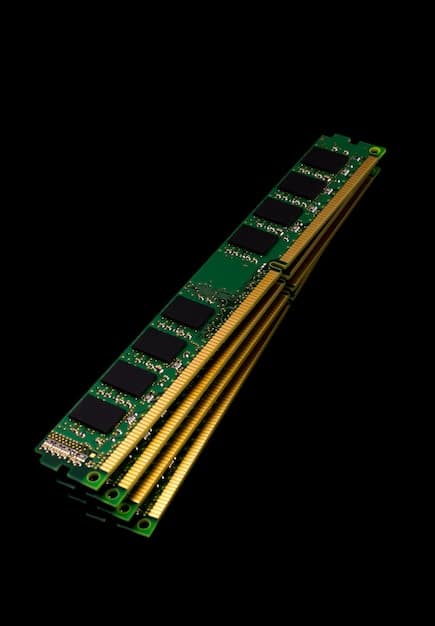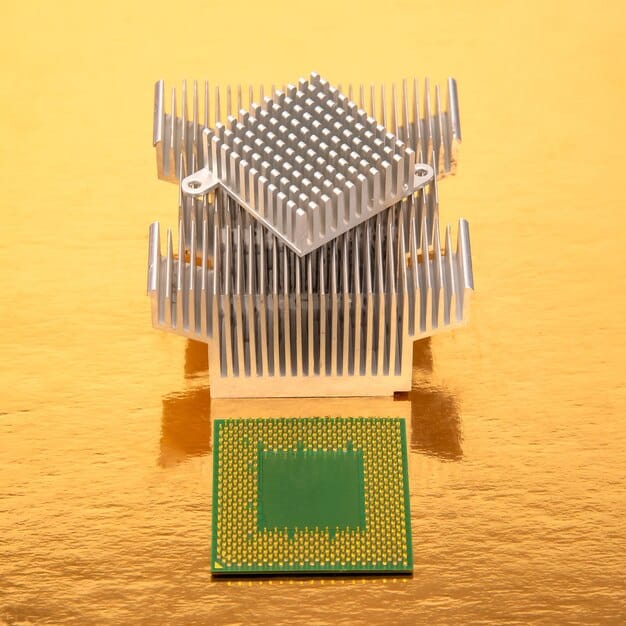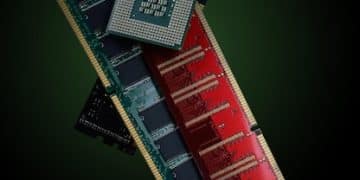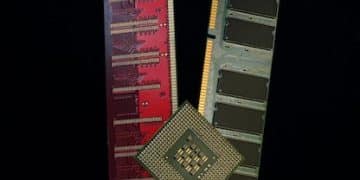NVIDIA CUDA Cores Explained: Gaming & Content Creation

NVIDIA CUDA Cores are the fundamental building blocks of NVIDIA GPUs, enabling parallel processing for enhanced performance in gaming, content creation, and other computationally intensive tasks.
Understanding the architecture behind your graphics card can unlock its full potential. Today, we dive deep into NVIDIA CUDA Cores Explained: Understanding Their Role in Gaming and Content Creation, unraveling how these processing units contribute to stunning visuals and accelerated workflows.
What are NVIDIA CUDA Cores?
NVIDIA CUDA (Compute Unified Device Architecture) Cores represent the parallel processing units within NVIDIA GPUs. These cores are designed to handle multiple computations simultaneously, making them ideal for tasks that can be broken down into smaller, independent operations.
But how do these cores differ from traditional CPU cores? Let’s explore.
CPU Cores vs. CUDA Cores
Traditional CPUs are designed for general-purpose computing and excel at sequential tasks. In contrast, CUDA Cores are optimized for parallel processing, allowing them to handle massive amounts of data concurrently.
Here’s a quick comparison:
- CPU Cores: Fewer in number, higher clock speeds, complex instruction sets. Ideal for tasks requiring strong single-core performance.
- CUDA Cores: Numerous, lower clock speeds, simpler instruction sets. Perfect for parallelizable workloads.
Understanding this distinction is crucial for appreciating the role of CUDA Cores in modern GPUs.

In summary, CUDA Cores are specialized processing units designed to accelerate parallel computations, making them a cornerstone of NVIDIA’s GPU architecture.
The Architecture of CUDA Cores
To truly understand CUDA Cores, it’s essential to delve into their architectural design. These cores are not standalone units but are organized into Streaming Multiprocessors (SMs).
Let’s break down the key components.
Streaming Multiprocessors (SMs)
An SM is a cluster of CUDA Cores, along with shared memory, registers, and other resources. The SM is the fundamental building block for executing parallel tasks on the GPU.
Here’s what an SM typically contains:
- CUDA Cores (e.g., 64, 128, or more)
- Shared Memory (for fast data access between cores)
- Register File (for storing variables)
- Warp Scheduler (manages the execution of warps)
The SM architecture enables efficient parallel processing by allowing CUDA Cores to work together on shared data.
Warps and Threads
CUDA Cores operate on threads, which are executed in groups called warps. A warp is a set of threads that execute the same instruction at the same time, a concept known as Single Instruction, Multiple Thread (SIMT).
Key aspects of warps include:
- Threads within a warp execute synchronously.
- If threads in a warp diverge (e.g., due to conditional branching), the warp serially executes each branch path.
- Efficient warp scheduling is crucial for maximizing GPU utilization.
By understanding the organization of CUDA Cores within SMs and the concept of warps, one can appreciate how NVIDIA GPUs achieve massive parallelism.
In conclusion, the architecture of CUDA Cores, organized into Streaming Multiprocessors and executing threads in warps, enables highly efficient parallel processing.
CUDA Cores in Gaming
Gaming is one of the primary applications where CUDA Cores shine. The parallel processing capabilities of GPUs powered by CUDA Cores enable real-time rendering of complex scenes, leading to immersive gaming experiences.
But how exactly do CUDA Cores contribute to gaming performance?
Real-Time Rendering
Real-time rendering involves rapidly calculating and displaying images on the screen. CUDA Cores accelerate this process by handling numerous tasks in parallel, such as:
- Vertex processing: Transforming 3D models into 2D screen coordinates.
- Pixel shading: Calculating the color and lighting of each pixel.
- Texture mapping: Applying textures to surfaces for added detail.
By offloading these tasks from the CPU to the GPU, CUDA Cores enable smoother frame rates and more detailed visuals.
Ray Tracing and DLSS
Modern games are increasingly incorporating ray tracing and Deep Learning Super Sampling (DLSS) technologies. CUDA Cores play a vital role in accelerating these advanced rendering techniques.
Here’s how:
- Ray Tracing: Simulates the behavior of light in a scene, creating realistic reflections and shadows. CUDA Cores accelerate the intersection calculations between rays and objects.
- DLSS: Uses deep learning to upscale lower-resolution images to higher resolutions, improving performance without sacrificing visual quality. CUDA Cores power the tensor cores that accelerate DLSS computations.

These technologies wouldn’t be feasible without the parallel processing power of CUDA Cores.
In short, CUDA Cores significantly enhance gaming performance by accelerating real-time rendering, ray tracing, and DLSS, leading to more immersive and visually stunning gaming experiences.
CUDA Cores in Content Creation
Beyond gaming, CUDA Cores are also instrumental in content creation applications. Video editing, 3D modeling, and graphic design software leverage the parallel processing capabilities of NVIDIA GPUs to accelerate workflows.
Let’s examine the specific benefits.
Video Editing and Rendering
Video editing involves complex tasks such as encoding, decoding, and applying visual effects. CUDA Cores accelerate these processes by:
- Enabling real-time playback of high-resolution footage.
- Reducing rendering times for complex projects.
- Accelerating the application of visual effects and color grading.
Software like Adobe Premiere Pro and DaVinci Resolve take advantage of CUDA Cores to provide a smoother and more efficient editing experience.
3D Modeling and Animation
3D modeling and animation are computationally intensive tasks that benefit greatly from GPU acceleration. CUDA Cores enable:
Faster viewport rendering: Allowing artists to interact with complex 3D scenes in real-time.
- Accelerated simulations: Reducing the time required for physics simulations and fluid dynamics.
- Improved rendering performance: Decreasing the time needed to create final, high-quality renders.
Applications like Blender and Autodesk Maya leverage CUDA Cores to enhance the creative process.
CUDA Cores significantly improve content creation workflows by accelerating video editing, 3D modeling, and other computationally intensive tasks.
Factors Affecting CUDA Core Performance
While the number of CUDA Cores is a significant factor in GPU performance, it’s not the only one. Several other factors influence how effectively CUDA Cores can contribute to overall performance.
Let’s explore these factors.
Clock Speed and Architecture
Clock speed and architecture play crucial roles in determining CUDA Core performance. Higher clock speeds generally translate to faster execution, while architectural improvements can increase efficiency.
Key considerations include:
Clock speed: The rate at which CUDA Cores execute instructions. Measured in MHz or GHz.
- Architecture: Design improvements in newer GPU architectures can lead to increased performance per CUDA Core.
- Memory Bandwidth: The speed at which CUDA Cores can access data in memory. Higher bandwidth enables faster data transfer.
These factors work in tandem to determine the overall processing power of the GPU.
Software Optimization and Drivers
Software optimization and drivers are essential for maximizing CUDA Core utilization. Well-optimized software can efficiently leverage the parallel processing capabilities of GPUs, while up-to-date drivers ensure compatibility and performance.
Important aspects include:
- CUDA Toolkit: NVIDIA’s development environment for creating CUDA-accelerated applications.
- Drivers: Regularly updated drivers provide bug fixes, performance improvements, and support for new hardware and software.
- Profiling Tools: Tools for analyzing GPU performance and identifying bottlenecks.
Optimizing software and drivers can significantly enhance the performance of CUDA Cores.
In summary, clock speed, architecture, software optimization, and drivers all play critical roles in determining the performance of CUDA Cores.
Future Trends in CUDA Core Technology
As technology evolves, CUDA Core architecture continues to advance. NVIDIA is constantly innovating to improve the performance and efficiency of its GPUs. Let’s explore some future trends in CUDA Core technology.
What can we expect in the coming years?
Architectural Enhancements
NVIDIA is expected to continue refining its GPU architecture, focusing on:
- Increasing the number of CUDA Cores: More cores enable greater parallel processing capabilities.
- Improving core efficiency: Reducing power consumption and increasing performance per core.
- Enhancing memory bandwidth: Enabling faster data transfer between CUDA Cores and memory.
These enhancements will lead to more powerful and efficient GPUs.
Integration with AI and Machine Learning
AI and machine learning are increasingly important areas for GPU acceleration. NVIDIA is likely to integrate CUDA Cores more tightly with tensor cores and other specialized hardware to enhance AI performance.
This includes:
- Optimizing CUDA Cores for deep learning workloads.
- Developing new programming models for AI applications.
- Creating specialized hardware accelerators for specific AI tasks.
This integration will drive innovation in both gaming and content creation.
In conclusion, future trends in CUDA Core technology include architectural enhancements and closer integration with AI and machine learning, promising even more powerful and efficient GPUs.
| Key Topic | Brief Description |
|---|---|
| 🎮 Gaming | Enhance real-time rendering and ray tracing for smoother, more detailed gameplay. |
| 🎬 Content Creation | Speed up video editing, 3D modeling, and other creative workflows. |
| ⚙️ Architecture | Organized into Streaming Multiprocessors (SMs) for efficient parallel processing. |
| 🚀 Future Trends | Architectural enhancements and AI/ML integration for even greater performance. |
Frequently Asked Questions
▼
CUDA Cores are parallel processing units within NVIDIA GPUs, designed to handle multiple computations simultaneously, crucial for tasks like gaming and content creation.
▼
They accelerate real-time rendering, ray tracing, and DLSS, enabling smoother frame rates and more detailed visuals in modern games.
▼
They accelerate video editing, 3D modeling, and graphic design tasks, reducing rendering times and enabling real-time playback of high-resolution footage.
▼
While the number of CUDA Cores is significant, clock speed, architecture, memory bandwidth, and software optimization also greatly influence GPU performance.
▼
Expect architectural enhancements, improved core efficiency, and tighter integration with AI and machine learning technologies for more powerful and efficient GPUs.
Conclusion
NVIDIA CUDA Cores Explained: Understanding Their Role in Gaming and Content Creation reveals that these processing units are essential for modern GPU performance. From accelerating real-time rendering in games to enhancing video editing and 3D modeling workflows, CUDA Cores unlock the full potential of NVIDIA GPUs. As technology continues to advance, innovations in CUDA Core architecture promise even more powerful and efficient solutions for a wide range of applications.





